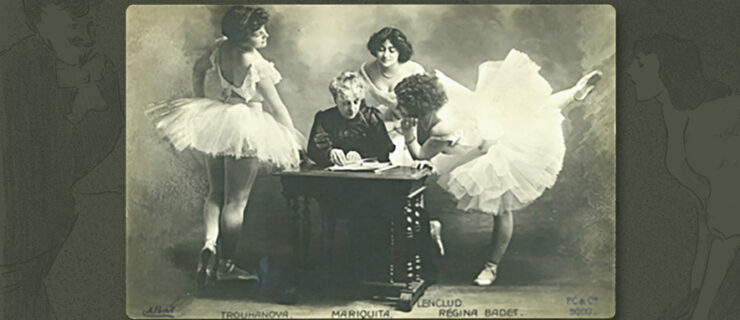Breaking the Binary: Trans, Gender-Fluid and Other Nonbinary Artists Are Seeking Equal Opportunity in Classical Ballet
George Balanchine famously said “Ballet is woman.” He should have added that ballet is man, too, because it has long been defined by the traditional male-female binary. A formal challenge to the paradigm was launched in June, when Chase Johnsey was offered the opportunity to dance female corps roles in English National Ballet’s The Sleeping Beauty in London.
“I am a classical ballerina,” says Johnsey, a freelance dancer who identifies as gender fluid and uses he/him/his pronouns. His ENB performance (in the mazurka and as a marchioness in the hunt scene; he also understudied a nymph) made headlines around the world and turned him into an activist for the cause—not to change classical ballet, but to open its doors to artists across the full spectrum of human gender. By hiring Johnsey, ENB artistic director Tamara Rojo put ballet’s gender-exclusiveness on notice. “Our work and our company should reflect the world we live in,” she stated via email. “Ballet should have no barriers; it’s for everyone, everywhere.”
Johnsey isn’t alone. Jayna Ledford and Scout Alexander, two young transgender dancers, are training hard to break into the professional ballet world. We spoke with them about the dreams, achievements and challenges of nonbinary artists in the intensely gendered world of ballet.
Embracing the Gender Spectrum

Gaynor Minden named Jayna Ledford a 2018-19 Gaynor Girl.
Dwayne Dunlap, Courtesy Ledford
Decades of research shows that human gender and sex are not limited to a strict male-female binary. The spectrum includes, but is not limited to, cisgender people, who identify with the sex assigned to them at birth; agender people, who identify with no gender; gender-fluid people, who identify as a unique blend that is not fixed on the spectrum; and trans people, who don’t identify with their assigned gender and who may (or may not) use clothing, cosmetics, hormones or surgery to transition to their authentic gender. People everywhere on the spectrum choose the pronouns (he/she/they, etc.) that feel right to them. (Gender is also extremely personal; we aren’t disclosing information that could compromise the dancers’ safety or well-being.)
Johnsey, 33, focuses on dancing female roles. For 14 years he was a star in the drag ballet company Les Ballets Trockadero de Monte Carlo, where his performances from Paquita, Don Quixote and Le Corsaire earned him a 2016 UK National Dance Award as Best Male Dancer. He resigned from the company last January, alleging harassment and discrimination (an internal investigation did not substantiate those allegations).
Regardless of his gender identity, Johnsey argues that his technical and artistic qualifications should make him eligible to dance in a traditional ballet company. “If I were in the back of the corps, and nobody noticed me, then what’s the issue? I’m not hurting anybody,” he says. “I’m trying to open possibilities for dancers.”
Males dancing females’ roles, and vice versa, is an issue for many people. Concerns range from unfair competition to a fear that ballet’s artistic standards will be diminished. “Some directors or choreographers simply don’t see it happening because it’s never been done,” says Johnsey. And in a New York Times article about Johnsey’s ENB debut, former New York City Ballet principal Wendy Whelan quipped, “If he is the best girl for the job, then great,” yet voiced concern about men already having fewer hurdles than women in ballet.
NYCB principal Ashley Bouder, a longtime fan of Johnsey’s and a supporter of inclusivity in ballet, feels that worries about nonbinary artists taking women’s jobs are overblown. “There are so few trans dancers that it doesn’t represent that big of a threat,” she says. “If nonbinary dancers get that job, they may just be better. That would be true for anybody.”
Indeed, Johnsey and the other dancers in this story want to dance at the highest possible level. Johnsey, for example, prepared for The Sleeping Beauty by taking women’s company class, working with ENB associate artistic director Loipa Araújo and developing longer, leaner musculature with ENB’s dance scientist through nutrition and cross-training. “A lot of my pointework wasn’t necessarily correct,” he says. “The world for females in ballet is very tough, and the work is a lot more detailed.”
Many have suggested that Johnsey would find more acceptance in contemporary dance. “What I am addressing is classical ballet,” he says, with obvious frustration. “I’m not gonna back down, because then I’m not fighting.” He cites Misty Copeland as a role model. “It wasn’t until she changed the world’s mind that the ballet world finally changed its mind.”
Fighting for Authenticity

“I had to choose between not dancing at all and living my truth,” says Scout Alexander.
Quinn De Anna, Courtesy Alexander
It can be difficult to grasp the elation a nonbinary dancer feels when they are finally able to dance as their true selves. “Up until about age 17, I was struggling with having to train mainly as female, because it was the only option I had,” recalls Scout Alexander, 19. The Cleveland dancer, who dreams of performing male roles in a major ballet company, was assigned female at birth and is transitioning to male, and uses male pronouns. “I had to choose between not dancing at all and living my truth.”
Facing backlash after coming out as trans at age 15, Alexander debated quitting ballet altogether. “I wasn’t sure if I’d be able to have a career and have this identity, because I had been told that the two couldn’t coexist.” Unsure if he would be able to train as a male at his studio, he enrolled in open evening classes elsewhere. “I could wear more what I wanted,” he says, “but it was not the intense training that I should have been having.”
Determined to be himself in the ballet world, Alexander left home at 18. He auditioned and earned a full male scholarship to BalletMet’s 2018–19 trainee program. “As long as a dancer can fully participate in our programs at the same or higher level as our other dancers, they are welcome,” says BalletMet executive director Sue Porter.
Alexander has deferred for a year while he adjusts to hormone treatment, recovers from surgery to flatten his chest and builds strength for partnering. In the meantime, he is a trainee with Inlet Dance Theatre, a contemporary company in Cleveland. “They’ve been absolutely amazing with accepting me and training me as 100 percent male,” he says. “Since I am so new into my transition, there’s a lot of things I’m way behind with compared to other guys my age.”
Making Hard Choices
“I just want to dance,” says Delaware dancer Jayna Ledford, 19, who was assigned male at birth and faced barriers early on. When Ledford started ballet lessons at age 5, “I asked if I could wear a leotard like the other students, and the teacher said no,” she recalls. As many studios do, her school hewed to the standard division between boys’ and girls’ training, and she was forced to leave. Ledford ultimately decided to conceal her gender identity, and went on to excel in men’s training.
Last January, though, she felt ready to come out as trans while on a full male scholarship at the Kirov Academy of Ballet in Washington, DC, and began using female pronouns. “It was really easy after that to just be myself, and it felt amazing,” she says. The students were immediately supportive, and the school made accommodations, such as exempting her from male partnering class. Last spring, she began hormone therapy and started pointe training.
In spite of Ledford’s long legs, dolphin arches and graceful port de bras, her status as a trans female could mean an uphill path to her dream roles of Juliet, Aurora and Kitri. “I’m nervous for Jayna,” says Michele Xiques, who has trained Ledford for five years and is director of First State Dance Academy in Milford, Delaware. “There’s not enough experiences out there for teachers and directors to turn to. How did you handle it? What were the guidelines? I just want to make Jayna feel safe and help as much as I can because she’s got the talent.”
Ledford completed her school year at the Kirov Academy in May, and in August decided she would train at home, catching up on pointe technique and dancing The Nutcracker Express in Delaware. (“I get to do new choreography,” Xiques says, “because she’s able to do jumps and turns that some born females aren’t capable of doing because she has so much strength.”) She’s considering applying for college.
“There are so many obstacles I have to overcome,” Ledford says. “I feel sad, but I’m not letting this stop me from doing what I want to do.”
These dancers are on the vanguard, and it can be a lonely place. Last spring Johnsey reached out to Ledford, and the two were eager to meet. “Lots of happy tears!” Ledford recalls of their visit in New York. Johnsey agrees: “It’s incredible to see in the flesh, right in front of your eyes, who you’re fighting for.”
Sean Dorsey assisted with this story.






